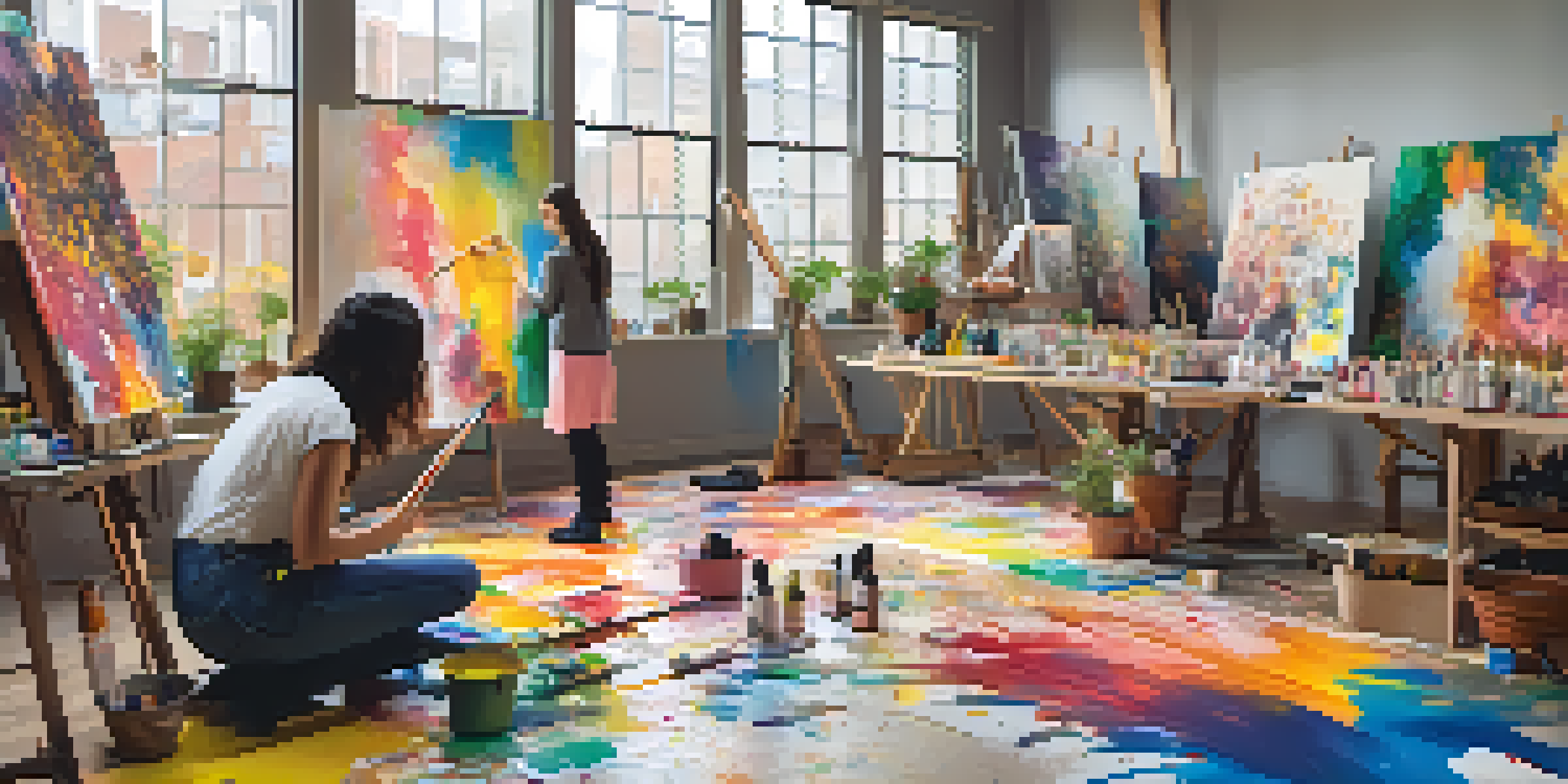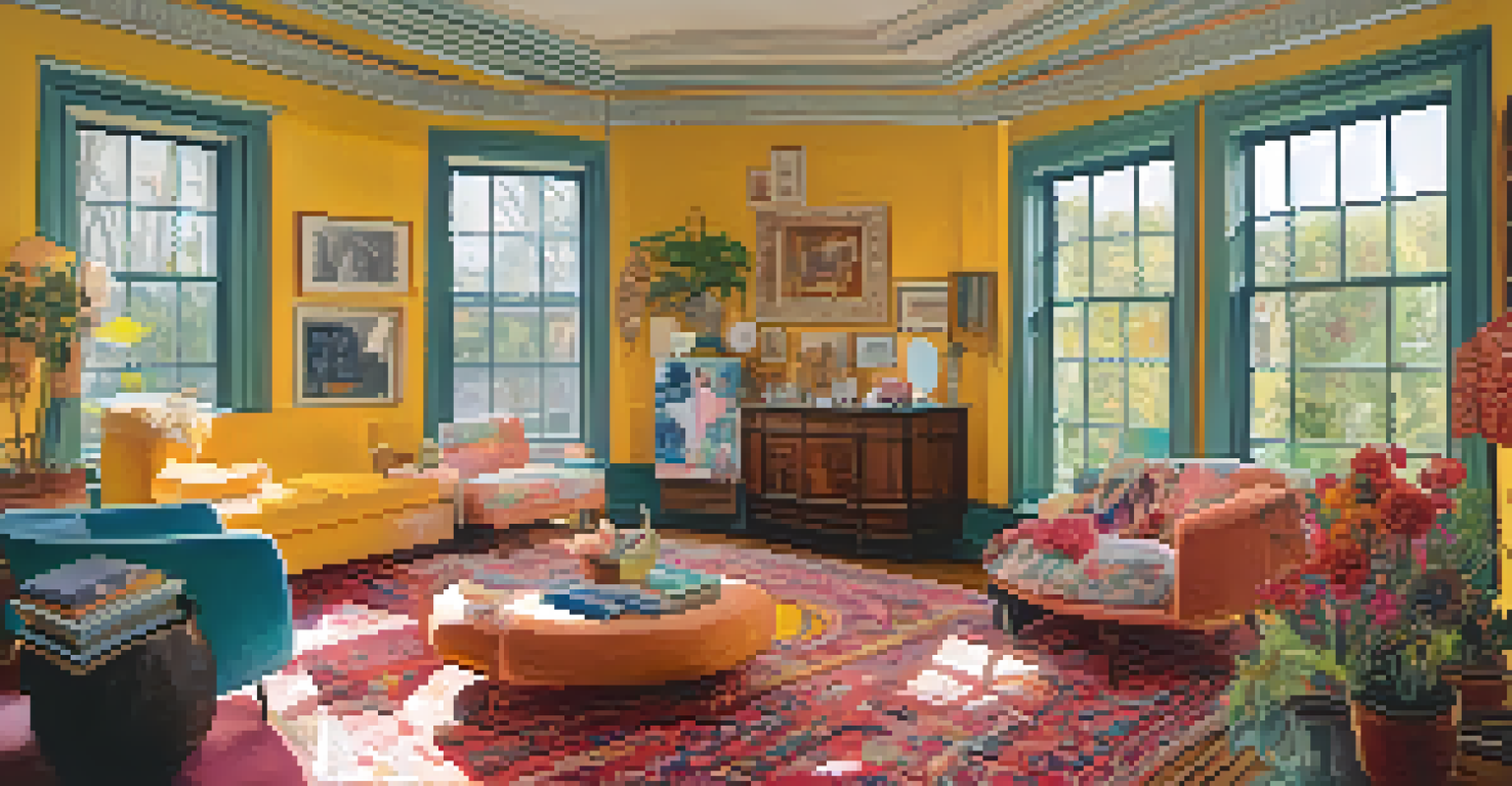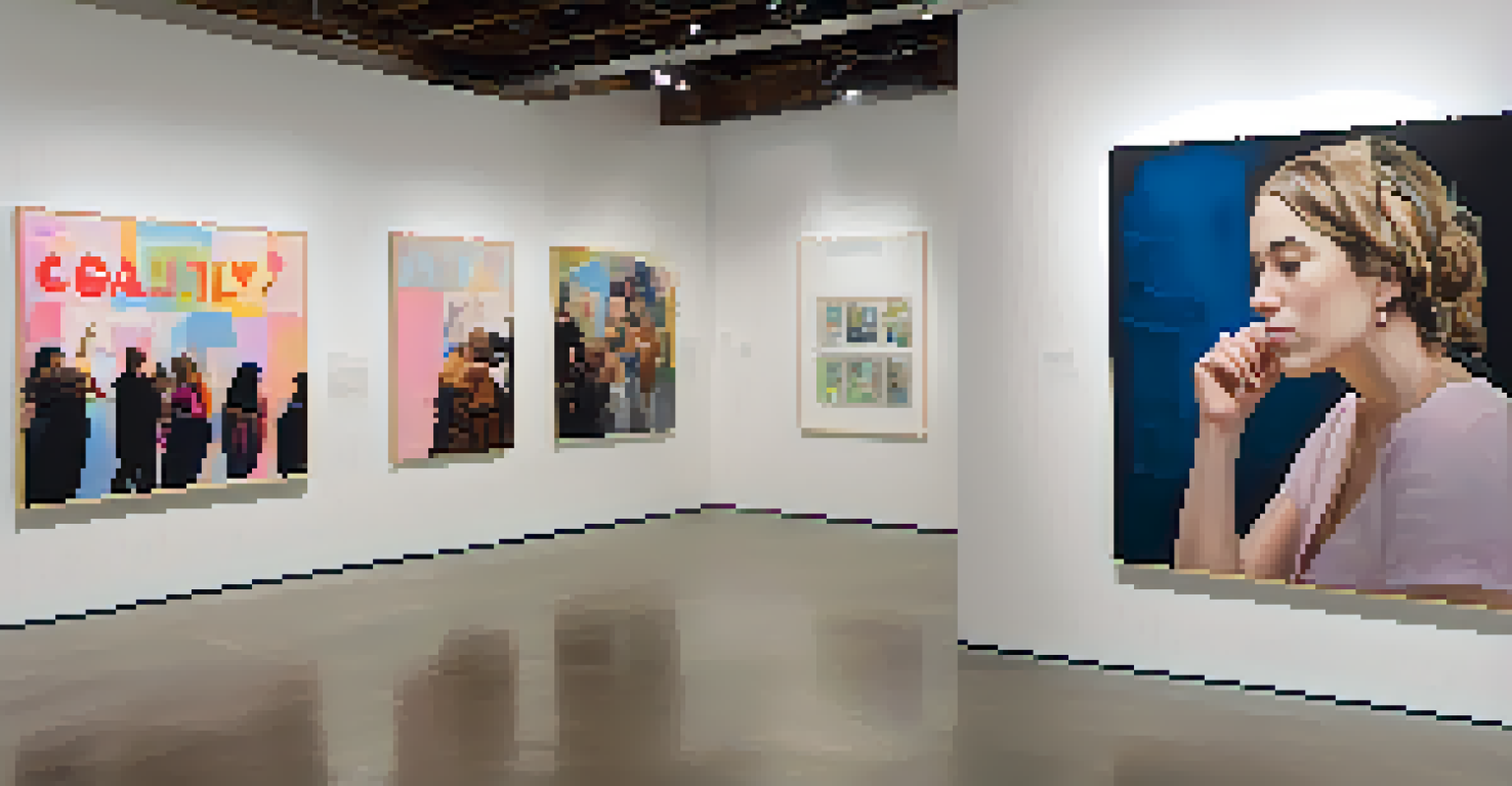Feminist Art Movement in California: Voices and Visions

The Origins of the Feminist Art Movement in California
The feminist art movement in California emerged in the late 1960s, fueled by the broader women's liberation movement. Artists began to challenge the male-dominated art world, seeking to create spaces where women's voices could be heard. This period marked a significant shift, as women artists sought to redefine what art could be and who could create it.
The feminist movement has been about claiming space for women's voices, and art is one of the most powerful mediums to do that.
In Los Angeles and San Francisco, key figures like Judy Chicago and Miriam Schapiro led the charge, forming collectives that emphasized collaboration and community. These artists not only produced works that highlighted women's experiences but also critiqued societal norms and expectations. The creation of the first Feminist Art Program at California State University, Fresno, in 1971 was a pivotal moment for education in this field.
As these artists rallied together, they captured the attention of the public and the art world alike. Their works often served as a form of protest, utilizing art as a means to discuss issues such as gender inequality, body politics, and identity. The movement's roots in California laid the foundation for feminist art that would resonate across the globe.
Key Figures of the California Feminist Art Scene
Prominent artists like Judy Chicago and Barbara Kruger became synonymous with the feminist art movement in California. Chicago's iconic installation, 'The Dinner Party,' is a prime example of how art can merge with activism, celebrating the contributions of women throughout history. This piece not only sparked conversations about gender but also challenged how art is presented and perceived.

Barbara Krer’s striking text-based works challenged the consumerist culture and societal norms that often objectified women. Her bold graphics and poignant messages pushed viewers to reconsider their perceptions of femininity and power. Artists like these were instrumental in highlighting women's issues through accessible and engaging visual language.
Feminist Art's California Roots
The feminist art movement in California emerged in the late 1960s, challenging traditional norms and creating spaces for women's voices.
Other influential artists, such as Joan Brown and Betye Saar, expanded the conversation by integrating personal narratives and cultural heritage into their work. These women not only created art that resonated with their own experiences but also connected broader themes of race, identity, and gender. Together, these key figures forged a path for future generations of women artists.
Art Collectives and Their Impact
Art collectives played a crucial role in the feminist art movement, providing a supportive environment for female artists to collaborate and share ideas. Groups like the Womanhouse collective in Los Angeles transformed a dilapidated house into a living gallery, where each room expressed different aspects of women's lives. This innovative project allowed artists to explore themes of domesticity and femininity in a powerful and immersive way.
Art should be a way of thinking about the world, a way to challenge the status quo and provoke change.
These collectives often served as incubators for new ideas and methods, proving that collaboration could lead to groundbreaking works. By working together, artists could amplify their voices and challenge the traditional art world, which often marginalized women's contributions. The sense of community fostered in these spaces empowered many to push boundaries and explore uncharted territories in their art.
Moreover, the impact of these collectives extended beyond individual artists. They provided a platform for discussions about gender, sexuality, and race, influencing the broader cultural landscape of California. The legacy of these art collectives continues to inspire and inform feminist art practices today.
Themes Explored in Feminist Art
Feminist art in California often tackled complex themes such as identity, body politics, and societal expectations. Artists used their work to question and deconstruct the roles assigned to women, providing a fresh perspective on what it means to be female in a patriarchal society. Through various mediums, they expressed the diversity of women's experiences, making their art both relatable and thought-provoking.
Many artists employed personal narratives, using their own stories as a lens through which to explore broader social issues. This approach not only humanized the struggles of women but also fostered a sense of solidarity among viewers. By sharing their experiences, these artists created a dialogue that resonated with many, encouraging others to reflect on their own identities.
Key Artists Redefining Art
Prominent figures like Judy Chicago and Barbara Kruger used their art to celebrate women's contributions and critique societal expectations.
Additionally, the use of non-traditional materials and techniques became a hallmark of feminist art. Artists experimented with textiles, found objects, and mixed media, challenging the notion of what constituted 'fine art.' This innovative spirit not only expanded the boundaries of artistic expression but also aligned with the movement's goal of redefining women's roles in society.
Exhibitions That Changed the Landscape
Major exhibitions played a significant role in bringing feminist art into the mainstream. Events like 'Reinventing the Wheel' at the Los Angeles County Museum of Art showcased the work of female artists and challenged the art community to recognize their contributions. These exhibitions served as platforms for visibility and dialogue, allowing artists to reach broader audiences.
One landmark exhibition, 'WACK! Art and the Feminist Revolution,' held at the Museum of Contemporary Art in Los Angeles, highlighted the historical significance of feminist art from the 1960s to the 1980s. By featuring a diverse array of artists, it underscored the movement's impact and evolution. Such exhibitions not only celebrated the artists but also educated the public about the movement's cultural relevance.
These showcases helped to solidify the place of feminist art within the larger art historical narrative. They prompted institutions to reconsider their collections and programming, leading to a more inclusive representation of women's contributions to art. The ongoing dialogue around these exhibitions continues to inspire new generations of feminist artists.
Legacy and Influence on Future Generations
The feminist art movement in California has left a lasting legacy that continues to influence artists today. Many contemporary artists draw inspiration from the themes and techniques pioneered by their predecessors, using their platforms to address current social issues. This generational dialogue highlights the ongoing relevance of feminist art in addressing gender inequality and advocating for women's rights.
Moreover, the movement has paved the way for increased representation of marginalized voices within the art world. Today, artists from diverse backgrounds are able to share their experiences and challenge societal norms, furthering the conversation around identity and intersectionality. The foundational work of California's feminist artists has opened doors for countless others.
Legacy of Community and Impact
Art collectives fostered collaboration and dialogue, leaving a lasting influence on feminist art that continues to inspire new generations.
As we move forward, the impact of the feminist art movement remains evident in both artistic practices and cultural discussions. It serves as a reminder of the power of art as a tool for social change, encouraging artists to use their voices to advocate for equity and justice in our world.
The Ongoing Relevance of Feminist Art
Feminist art continues to resonate powerfully in today's cultural landscape, addressing contemporary issues such as sexual harassment, body image, and gender inequality. Artists today are building on the groundwork laid by their predecessors, using art to challenge the status quo and inspire change. This ongoing relevance is a testament to the strength and resilience of the feminist art movement.
Social media has also played a crucial role in the visibility of feminist art, allowing artists to share their work and messages with a global audience. Platforms like Instagram have become vital spaces for feminist artists to connect, collaborate, and engage with their followers. This democratization of art has enabled a wider range of voices to be heard, further enriching the feminist discourse.

As we reflect on the feminist art movement in California, it's clear that its legacy will continue to inspire and empower future generations of artists. The movement has provided a framework for understanding and addressing the complexities of women's experiences, ensuring that the conversation around gender and art remains vibrant and dynamic.